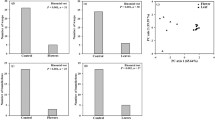Abstract
The Japanese beetle is a polyphagous insect that typically aggregates on preferred host plants in the field. We studied the response of Japanese beetles to artificial damage, fresh feeding damage, and overnight feeding damage to test the hypothesis that beetles are attracted to feeding-induced volatiles. Crabapple leaves that had been damaged overnight by Japanese beetles or fall webworms attracted significantly more Japanese beetles than did undamaged leaves. Artificially damaged leaves or leaves freshly damaged by Japanese beetles, however, were not significantly more attractive than undamaged leaves. Leaves that had been damaged overnight by Japanese beetles or fall webworms produced a complex mixture of aliphatic compounds, phenylpropanoid-derived compounds, and terpenoids. In comparison, artificially damaged leaves or leaves with fresh Japanese beetle feeding damage generated a less complex blend of volatiles, mainly consisting of green-leaf odors. Feeding-induced odors may facilitate host location and/or mate finding by the Japanese beetle.
Similar content being viewed by others
References
Adler, V.E., andJacobson, M. 1971. Electroantennogram response of adult male and female Japanese beetles to their extracts.J. Econ. Entomol. 64:1561–1562.
Borden, J.H. 1984. Semiochemical-mediated aggregation and dispersion in the Coleoptera, pp. 123–149,in T. Lewis (ed.). Insect Communication. Academic Press, Orlando.
Cooper, M.S., Heaney, H., Newbold, A.J., andSanderson, W.R. 1990. Oxidation reactions using urea-hydrogen peroxide; A safe alternative to anhydrous hydrogen peroxide.Synlett 9:533–535.
Cross, J.H. 1980. A vapor collection and thermal desorption method to measure semiochemical release rates from controlled release formulations.J. Chem. Ecol. 6:781–787.
Domek, J.M., andJohnson, D.T. 1988. Demonstration of semiochemically induced aggregation in the green June beetle,Cotinis nitida (L.) (Coleoptera: Scarabaeidae).Environ. Entomol. 17:147–149.
Fleming, W.E. 1972. Biology of the Japanese Beetle. U.S. Department of Agriculture Technical Bulletin 1449. Washington, D.C. 129 pp.
Gaydou, E.M., Randriamiharisoa, R., andBianchi, J.-P. 1986. Composition of the essential oil of ylang-ylang (Cananga odorata Hook Fil. et Thomsonforma genuina) from Madagascar.J. Agric. Food Chem. 34:481–487.
Harari, A.R., Ben-Yakir, D., andRosen D. 1994. Mechanism of aggregation behavior inMaladera matrida Argaman (Coleoptera: Scarabaeidae).J. Chem. Ecol. 20:361–371.
Hatanaka, A. 1993. The biogeneration of green odour by green leaves.Phytochemistry 34:1201–1218.
Hollander, M., andWolfe, D.A. 1973. Nonparametric Statistical Methods. John Wiley & Sons, New York, pp. 68–75.
Hunt, D.W.A., andBorden, J.H. 1990. Conversion of verbenols to verbenone by yeasts isolated fromDendroctonus ponderosae (Coleoptera: Scolytidae).J. Chem. Ecol. 16:1385–1397.
Iwabuchi, K., andTakahashi, J. 1983. Aggregative distribution pattern of the Japanese beetle,Popillia japonica Newman (Coleoptera: Scarabaeidae), and the role of former occupants in the formation of an aggregation.Appl. Entomol. Zool. 18:324–329.
Ladd, T.L. 1966. Egg viability and longevity of Japanese beetles treated with tepa, apholate, and metepa.J. Econ. Entomol. 59:422–425.
Ladd, T.L. 1970. Sex attraction in the Japanese beetle.J. Econ. Entomol. 63:905–908.
Ladd, T.L. 1987. Influence of food, age, and mating on production of fertile eggs by Japanese beetles (Coleoptera: Scarabaeidae).J. Econ. Entomol. 80:93–95.
Leius, K. 1960. Attractiveness of different foods and flowers to the adults of some hymenopterous parasites.Can. Entomol. 92:369–376.
Loughrin, J.H., Manukian, A., Heath, R.R., Turlings, T.C.J., andTumlinson, J.H. 1994. Diurnal cycle of emission of induced volatile terpenoids by herbivore-injured cotton plants.Proc. Natl. Acad. Sci. U.S.A. 91:11836–11840.
Schwartz, P.H., andHamilton, D.W. 1969. Attractants for the Japanese beetle.J. Econ. Entomol. 62:516–517.
Sokal, R.R., andRohlf, F.J. 1981. Biometry—The Principles and Practice of Statistics in Biological Research. W.H. Freeman and Company, San Francisco. p. 244.
Tumlinson, J.H., Klein, M.G., Doolittle, R.E., Ladd, T.L., andProveaux, A.T. 1977. Identification of the female Japanese beetle sex pheromone: Inhibition of male response by an enantiomer.Science 197:789–792.
Turlings, T.C.J., Tumlinson, J.H., andLewis, W.J. 1990. Exploitation of herbivore-induced plant odors by host-seeking parasitic wasps.Science 250:1251–1253.
Turlings, T.C.J., Loughrin, J.H., McCall, P.J., Röse, U.S.R., Lewis, W.J., andTumlinson, J.H. 1995. How caterpillar-damaged plants protect themselves by attracting parasitic wasps.Proc. Natl. Acad. Sci. U.S.A. 92:4169–4174.
Van Leeuwen, E.R., Anderson, O.G., andVander Meulen, P.A. 1928. Some phases of Japanese beetle investigations.J. Econ. Entomol. 21:805–813.
Yearian, W.C., Gilbert, K.L., andWarren, L.O. 1966. Rearing the fall webworm,Hyphantria cunea (Drury) (Lepidoptera: Artiidae), on a wheatgerm medium.J. Kans. Entomol. Soc. 39:495–499.
Author information
Authors and Affiliations
Rights and permissions
About this article
Cite this article
Loughrin, J.H., Potter, D.A. & Hamilton-Kemp, T.R. Volatile compounds induced by herbivory act as aggregation kairomones for the Japanese beetle (Popillia japonica Newman). J Chem Ecol 21, 1457–1467 (1995). https://doi.org/10.1007/BF02035145
Received:
Accepted:
Issue Date:
DOI: https://doi.org/10.1007/BF02035145




